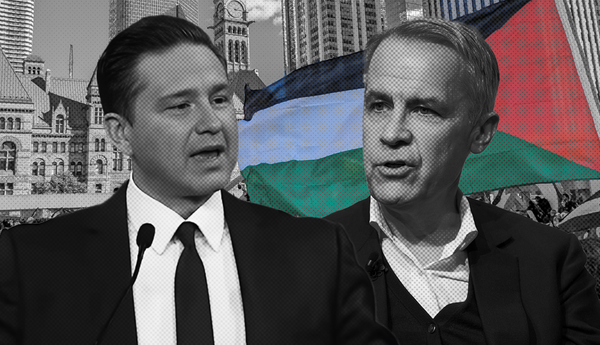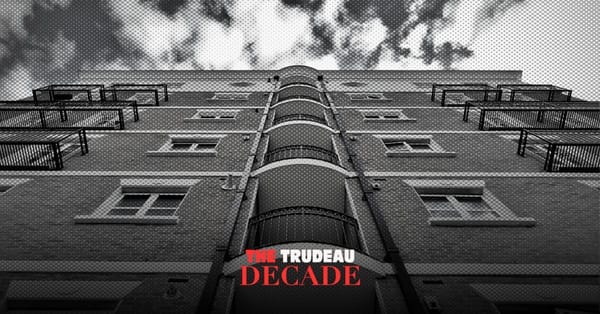Canada has welcomed an average of more than 278,000 people as immigrants over each of the past 10 years.
That’s how the federal government frames it, anyways — like immigrants are checking into the great Canadian hotel, being given gift baskets and complimentary breakfast options. But applying for permanent residency (PR) in Canada is way harder than deciding which tiny cereal box you want.
Applying for PR means having to deal with a lot of bullshit.
The system is expensive, and has limited eligibility criteria that categorizes people by how much money they earn. It’s also deeply discriminatory, and is administered by a government department that doesn’t want to help.
It’s in everyone’s best interests, whether you were born in so-called Canada or outside it, to push for a more fair and just immigration system.
The Costs
Canada is often held up as a Western country that’s easy to immigrate to: it’s rated fourth in the world by the Migrant Integration Policy Index, with a process that’s cheaper, or has more lenient criteria, than places like the United States, the United Kingdom or Australia. But being better than somewhere terrible doesn’t mean the current system is good — or affordable.
The cost for applying to the economic PR application stream — a common path — is $1,325 per person: $825 for processing, and $500 for the mysteriously named “right of permanent residence fee.”
But in order to be allowed to hand that money over, you have to pay a lot of other costs to access all the necessary documents. These are done through private systems, so the costs can vary hugely. (I’ve included in parenthesis what each step has cost for me and my partner, to give you an idea of the amount of money at play.)
You must pay for: a police record from your home country ($181.92); a mandatory medical exam ($270), blood test ($70) and chest x-ray ($100); an accredited English or French test ($325); and getting your biometrics taken ($85). There may be additional costs to get documents notarized ($40) or translated, to have foreign education or training credentials standardized ($268), or to speak with an immigration lawyer to figure out the whole system in the first place. If you’re applying through a provincial nomination scheme, there’s an extra amount to pay (up to $2,000 for people looking to live in Ontario).
For myself and my partner — with all of our documents in English, no dependents and no provincial nominee fee — the cost currently stands at $4,581.84 for the two of us, and will likely only increase as we realize all the bits of paperwork we’ve overlooked.
That’s a lot of money to put down all at once. CBC estimated that the average person in Canada saved $5,574 during 2020, compared to just $479 in 2019. That figure is likely driven by households with stable employment who were able to cut back on personal service or entertainment spending. Immigrants — even those with some kind of permanent, full-time job that allows them to apply for PR — probably aren’t in the same financial boat as the “average” Canadian; chances are they’re younger, earn less money, don’t own property or are more likely to send money to family back home.
Many permanent residents apply from within Canada, coming here initially on a temporary worker or study permit — and so, this isn’t the first time they’ll be sending thousands of dollars to Canadian immigration hoping it works. (For students, there’s an additional cost to apply for a post-graduation work permit, meaning PR is likely the third time they’ll have to navigate the endless bureaucracy.)
In effect, the cost to apply for PR is a significant barrier to many.
The Eligibility
The PR system essentially stratifies people into different kinds of immigrants. Permanent residency is for the ‘good ones,’ who have already paid thousands for a legal work permit, got themselves a permanent full-time job and don’t have health conditions (or family members with health conditions) that might cost the healthcare system too much money.
However, not a lot of jobs these days are full-time and permanent. Canada’s labour market has increasingly turned away from stable jobs and into short-term contracts, part-time work or perma-freelancing situations.
Getting hired as a temporary resident is also tricky: businesses can more easily hire a permanent resident or citizen, and not have to worry about potentially needing to submit a Labour Market Impact Assessment.
Depending on what program you’re applying under, you may be eligible based on work experience in your current country of residence, or for work you’ve done in Canada. Even still, you often need a lot of documents from your employer to prove PR eligibility, so employers may be more reluctant to hire you, resulting in working jobs for which you’re significantly overqualified.
On top of that, you need to have a certain type of job. Occupations are graded by how “skilled” they are: you’re only eligible if your job is considered highly skilled enough. Generally, immigration-friendly jobs require a university degree or some other form of formal training, or are managerial. This means temporary workers in many essential jobs (such as cleaners, cashiers or couriers) aren’t eligible for PR.
In addition, “skilled” immigrants applying from overseas also have to prove that they have enough money to provide for themselves — starting at more than $13,200 for a single person.
This May, the federal government opened a scheme that allowed up to 30,000 temporary residents in essential (non-healthcare) jobs to apply for permanent residency. It was intended to run until November or when it reached capacity. It was full by mid-July, which indicates there were plenty of temporary workers doing essential, customer-facing jobs that actively put them at risk, who didn’t get the chance to apply.
Canada has huge numbers of temporary residents — the government issued 402,000 study permits and 404,000 temporary work permits in 2019 — but the hoops you need to jump through to get PR means that many of these people, who may desperately want to stay in Canada forever, can’t. Short-term workers are also especially likely to be exploited: lack of protections means they’re often unable to speak up about poor treatment on the job, lest they be deported.
Due to the relative lack of accepted permanent residents versus the number of temporary workers, many short-term workers eventually become undocumented. A 2007 RCMP survey estimated that there were 500,000 undocumented migrants in Canada, but that number is likely much higher now.
As Syed Hussan writes in Briarpatch, “Undocumented workers can apply for permanent residency through humanitarian and compassionate applications, but applications are difficult and expensive and acceptance rates are incredibly low. As more people enter the country on temporary permits, more will be made undocumented.”
Canada loves to use short-term foreign labour to keep the economy running. But it doesn’t love the workers back.
The IRCC
So, you’ve spent a while working a job that qualifies you for permanent residency, saved up your money, done your tests, filled out the forms and sent off the application. Now it’s up to Immigration, Refugees and Citizenship Canada (IRCC) to process the request. That’s supposed to be done within six months — but it can take far longer. For those applying from overseas, the pandemic has pushed processing time into years.
There also isn’t a good way to know what’s happening: You can file an access to information request to find out when your case file was last looked at, but there’s no way to make the IRCC assess it any faster. Your application gets black-boxed.
IRCC is the most complained-about federal institution. In 2019-2020, IRCC received 116,928 access to information requests (42 per cent more than 2018-19), and 4,298 complaints (670 per cent more than 2018-19).
The Information Commissioner of Canada tabled a report in May that investigated “the dramatic increase in complaints filed against IRCC in recent years,” which concluded that “the extraordinarily high number of requests, and correspondingly high numbers of complaints, is the direct result of applicants and/or their representatives being unable to obtain information they are seeking.”
More anecdotally, nobody I know personally has had a good experience with PR. I know: someone who had eligibility requirements change while her application was processing, setting her back two years; a couple who were deemed not useful to Canada despite one of them being a nurse; a woman whose green card took two years to process, leaving her unable to legally work while she waited; someone else whose application was denied, then reversed once he raised the money to appeal the decision in court.
Taken together, this paints a picture of the worst kind of bureaucracy — one where officers will reject applications so they can “move on to their next task,” ignore old applications in favour of processing new ones within six months, and leave applicants in the dark about what’s going on.
The Solution
There’s various different ways to help fix immigration, ranging from banal to revolutionary.
First, there’s what’s already happening: the IRCC can hire more officers to process cases, and commit to implementing the steps that the Information Commissioner has outlined to improve transparency. That’s the easy stuff.
The government can also abolish the medical exam and the invasive questioning of immediate family members’ medical conditions. Both are ableist and exclusionary: health shouldn’t be a factor in immigration, which is fundamentally an economic or labour issue.
Next, the government can overhaul what programs applicants are eligible under. There’s a whole web of them, depending on if you’re applying provincially or federally, or as a refugee, or through family reunification, or anything else. Anything with work requires a certain level, or sometimes even a certain income threshold; what if the government just allowed every immigrant with a job, no matter its class, to stay?
But immigrants are also less likely to get hired into jobs, full stop. So tying immigration to job status would still lead to migrants being unable to stay due to discriminatory hiring practices. And people shouldn’t be deemed worthy or not based on their employment status anyways; so what if Canada didn’t tie immigration to jobs at all?
What if Canada became a country of open borders?
Many groups have been pushing for this for a long time. Migrant Rights Network, for instance, demands permanent residency for all immigrants — not just the right to stay in Canada indefinitely, but the right to be treated equally to others.
No One Is Illegal is premised on the idea that people migrating in search of a better life should not and cannot be illegal. The group juxtaposes that against the way countries steal land and engage in colonial practices to expand borders. (One of their slogans is “Canada Is Illegal.”)
Canada opening its borders could look like giving all current temporary and undocumented residents leave to stay permanently, without making them apply and pay endless fees to do so. The country could offer language classes instead of language tests, or provide employment training instead of employment barriers.
Instead of kicking away people, why not help them? That’s what a country that welcomes immigrants would really look like.







